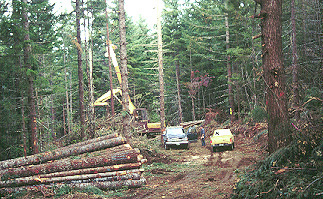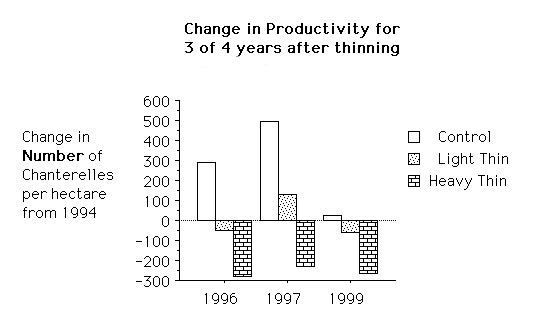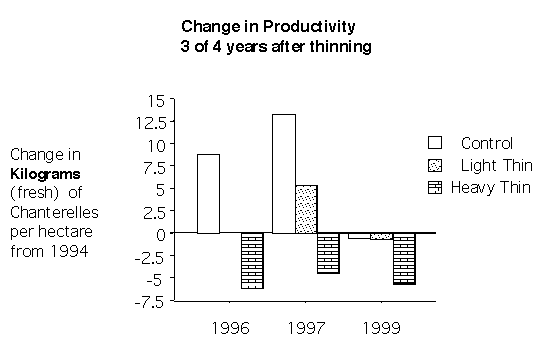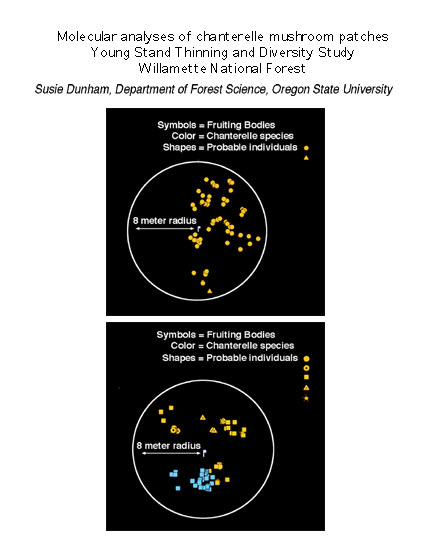CHANTERELLE MUSHROOM PRODUCTIVITY
RESPONSES TO YOUNG STAND
THINNING
Young Stand Thinning and Diversity Study
CHANTERELLE MUSHROOM PRODUCTIVITY
RESPONSES TO YOUNG STAND
THINNING
Young Stand Thinning and Diversity Study
|
|
 |
| The Pacific golden chanterelle | Young (50 years) Douglas-fir forest being commercially thinned |
Edible mushrooms have been widely
collected from the forests of the Pacific Northwest since European settlers
began hunting for mushrooms they had collected in their homelands. (Some
native tribes harvested a few mushroom species, but we lack evidence of
their wide-spread consumption). During the 1990's, commercial mushroom
harvesting has expanded dramatically as international markets have developed
and forest workers seek means to supplement their income.
|
|
|
|
|
|
|
|
National Forest lands provide ideal habitat for many types of edible forest mushrooms and managers have developed permits and regulations that allow commercial harvesting.
Baskets of chanterelles lined up at a buying station Photo courtesy of Eric Jones
|
|
| Strategically placed signs are a management tool for communicating with the public (and vice versa!) |
Chanterelles are one of the most
frequently harvested mushrooms in our National Forests. The Pacific golden
chanterelle, Cantharellus formosus (formerly C. cibarius),
and the white chanterelle,
C. subalbidus, are the two most
common chanterelles in the low elevation forests on the west side of the
Cascade Range. Both occur abundantly in young forests regenerated from
earlier logging.
|
|
|
|
The Pacific golden chanterelle |
The white chanterelle |
C. formosus and
C.subalbidus
are mycorrhizal fungi, that is, fungi that form symbiotic relations with
the roots of certain conifers, especially Douglas-fir and western hemlock.Mycorrhizal
fungi form
a web of "hyphae" (one cell wide threads collectively known as "mycelium")
in the soil and also colonize the young root tips of their arboreal hosts.
|
|
|
|
The fungus functions as an extended fine root system, absorbing water and minerals that are translocated to the tree and, in return, the trees provide the fungus with food (carbohydrates photosynthesized by the tree). The Pacific golden chanterelle and white chanterelle are the fruiting bodies of these Cantharellus species.
Many of the young forests where chanterelles occur are dense and scheduled for commercial thinning in the coming decades. Young stand thinning will likely affect chanterelle productivity (number and weight of mushrooms per acre) by altering a number of factors:
1. Food supplies for the fungus (density and health of host trees)
2. Environmental conditions near the forest floor that affect fruiting (temperature, humidity, and light levels)
3. Soil conditions (compaction,
summer and early autumn moisture levels, distribution of rotted wood and
organic matter in the soil profile, litter layer thickness, slash burning,
and microbial population shifts)
The Young Stand Thinning and Diversity Study on the Blue River, McKenzie and Oakridge Ranger Districts of the Willamette National Forest is an well-replicated, long-term, integrated ecosystem study that is ideal for understanding how chanterelles respond to thinning.
The Study
The study design is replicated on four sites and we are monitoring chanterelle productivity in three stand treatments at each site:
1. Control ~615 original trees
per hectare (250 trees per acre)
| Dense, naturally-regenerated 50 year old Douglas-fir stand typical of control stands in the study |
2. Light thin ~270 residual trees
per hectare (110 trees per acre)
| Young stand after light thinning. "No mushroom-picking" signs with universal slash symbol asks the public to avoid picking in the study area. |
3. Heavy thin ~125 residual trees
per hectare (50 trees per acre) with underplanting
| Young stand after heavy thinning. The thin canopy allows the forest floor to wet more quickly during rainstorms and dry more quickly during clear weather. Residual logging slash will make chanterelles more difficult to find until it decays. |
The study's primary goal is to examine the response (over time) of chanterelle productivity to the thinning treatments. We hypothesize that productivity will decline immediately after thinning (more so, the more heavily thinned) and then eventually rebound to higher than pre-thinning levels as the residual trees begin to grow more vigorously and fully occupy their habitat.
Little prior work had been done
on developing efficient and practical methods for sampling edible mushrooms
under a variety of field conditions, hence examining sampling methodology
also was a research goal.
| Long narrow strip plots may be more likely to intersect chanterelles clustered in patches than equal-sized circular or square plots. Also, because large sample areas and plot sizes are needed, field personnel find it easier to keep track of where they have already searched in strip plots than in circular plots (especially in brushy areas). | Large chanterelle patches were mapped in each stand to track how individual colonies of chanterelles respond to mortality of some of the adjacent host trees as a result of thinning. These circular plots are also proving useful for genetic analyses of chanterelle populations. |
Additional goals include spatial
analysis of how mapped chanterelle patches respond to removal of nearby
host trees, DNA analyses of mapped fruiting bodies to determine the number
and distribution of genetically unique mycelial colonies, and then combining
those analyses to investigate how chanterelle populations respond to the
thinning disturbances.
|
|
| Chanterelles exhibit a range of color variations on the study sites, complicating efforts to distinguish yellow from white chanterelles. Often white chanterelles will stain yellow and yellow chanterelles are whiter when not exposed to light. Genetic analyses have confirmed that distinct species exist on the study sites, but they were combined in our productivity analyses. |
Sampling Methods Results
Long (100-400 meters or 300-1200
feet ) narrow (5 meters or 15 feet) strip plots worked well for sampling
spatially clustered chanterelles while keeping track of what areas had
already been searched (especially in dense brush). Total sample areas need
to be large (~ 0.4 hectare or 1 acre) to derive useful estimates. Crew
members walked on the 5 meter wide plots, so some trampling of young mushrooms
may have occurred.
Productivity and Thinning Treatment Results
Productivity data have been collected
for one year prior to logging (1994) and three of four years afterwards
(1996,1997, and 1999). Chanterelles were found on every site (although
not every year) and productivity varied widely among both sites and years.
The range was 0 - 1042 chanterelles per hectare (0 - 422 per acre) and
0 - 34 kilograms per hectare (0 - 30 pounds per acre). Because productivity
varied greatly among replicate sites prior to thinning, the Analysis of
Variance (Repeated measures ANOVA) for thinning treatments was based on
the annual increase or decrease in fruiting compared to pre-logging (1994)
productivity levels for each replicate. As predicted, chanterelle productivity
significantly (p<0.05) declined (but was not eliminated) immediately
after thinning and the level of decline was greater in the heavily thinned
stands than in those lightly thinned. The first two charts below show declines
in numbers of chanterelles per hectare and fresh kilograms per hectare.
The 3rd chart examines potential recovery (not yet significant) of productivity
over time. Removal of ectomycorrhizal host trees, drier forest floors,
and layers of slash that make chanterelles difficult to find likely all
contributed to the decline.



Genetic Analysis Results
Genetic analysis of chanterelles
fruiting in the circular plots indicates significant genetic diversity
within seemingly uniform patches of fruiting bodies. Illustrated below
are two patches, a relatively uniform patch (mostly one individual of one
species) and a diverse patch (five individuals and two species). An unnamed
chanterelle species was discovered in these analyses and is in the process
of being described and named.

Taste Test Results
In the autumn of 1999, the H.J. Andrews Experimental Forest hosted a gathering of western mycologists. Three species of chanterelles were collected:
C. formosus, the common Pacific golden chanterelle of Douglas-fir/western hemlock forests.
C. subalbidus, the white chanterelle
C. cibarius v. roseocanus, the recently named "rainbow chanterelle" of spruce forests.
A blind taste test was conducted to compare their flavor. All three were sauteed in an iron skillet with olive oil and tasters ranked them in order of preference. Preference ranks were assigned arbitrary values and summed. Results indicated that our two species (C. subalbidus and C. cibarius v. roseocanus) that are more closely related to the European C. cibarius , are more flavorful than the Pacific Golden chanterelle, C. formosus.
C. subalbidus = 49
C. cibarius v. roseocanus = 47
C. formosus = 38
Application
Although chanterelles are only one of the many products and amenities that we derive from our forests, they are an integral part of the forest ecosystem and provide many people with pleasure and income. Forest managers will be able to better insure their continued availability if they understand the relations between management activities and chanterelle productivity. With this understanding, managers can continue to provide opportunities to harvest chanterelles in areas that have compatible management goals and convenient access.
David Pilz, Botanist (Harvested Forest Fungi), Pacific Northwest (PNW) Research Station, U.S. Department of Agriculture, Forest Service,Forestry Sciences Laboratory (FSL), 3200 SW Jefferson Way, Corvallis, Oregon 97331 U.S.A.Phone: (541) 750-7362. Fax: (541) 750-7329. E-mail: pilzd@fs.fed.us
Randy Molina, Research Botanist & Mycology TeamLeader, PNW Research Station, U.S. Department of Agriculture, Forest Service, Forestry Sciences Laboratory (FSL), 3200 SW Jefferson Way, Corvallis, Oregon 97331 U.S.A. Phone: (541) 750-7391. Fax: (541) 750-7329. E-mail: molinar@fs.fed.us
Jim Mayo, Silviculturalist,
Cascade
Center for Ecosystem Management,
Blue
River Ranger District,
Willamette
National Forest,P.O. Box 199, Blue
River, OR 97413. Phone:
(541) 822-3317. E-mail: jmayo@fs.fed.us
Research on the Chanterelle Productivity Responses portion of the Young Stand Thinning and Diversity Study was coordinated by scientists with the USDA Forest Service, Pacific Northwest Research Station. For further information on our Edible Forest Mushroom Research Program, visit our web page or contact us at the addresses listed above.